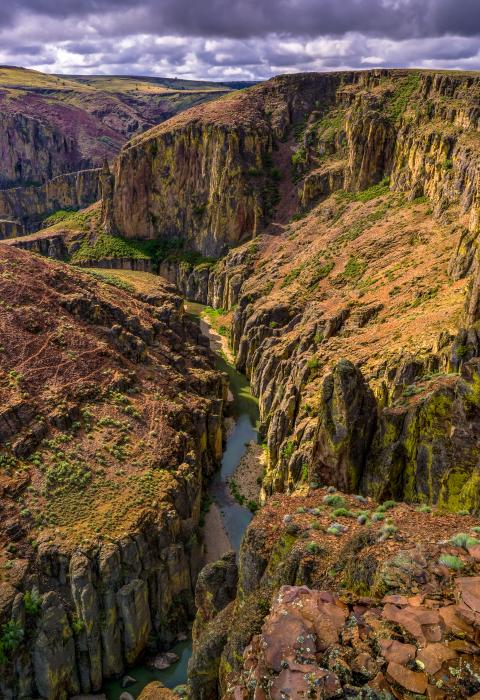Dickshooter Creek
Idaho
Dickshooter Creek begins west of Dickshooter, Idaho, and flows south, cutting a narrow, deep gorge through the rolling plateau landscape until it joins Deep Creek. The waters of Dickshooter cease to flow by late-spring to early summer, leaving behind only isolated pools in the gravel streambed. This canyon provides outstanding hiking and backpacking opportunities.
Designated Reach
March 30, 2009. Dickshooter Creek from its confluence with Deep Creek to a point on the stream 1/4 mile due west of the east boundary of Section 16, Township 12 South, Range 2 West, Boise Meridian.
Outstandingly Remarkable Values
Fish
Deep Creek supports sensitive redband trout populations and several reptile and amphibian species (frogs, toads, and salamanders).
Geology
Dickshooter Creek is part of the Owyhee, Bruneau, and Jarbidge river systems, which provide the largest concentration of rhyolite/basalt canyons in the western United States, products of Miocene Era (23 to 5 million years ago) volcanic formations. Where overlying basalt is present, rhyolite (rock which began as lava flow) formations are nestled in the rubble slopes below vertical walls of basalt. Weathering and erosion have carved monolithic cliffs and numerous sculptured pinnacles known as "hoodoos."
Recreation
Outstanding day-hiking opportunities are available, especially during low-water periods. Due to its meandering character, diversity of landforms, and topographic screening, Dickshooter Creek also provides exceptional opportunities for solitude and for primitive and physically challenging wildlife viewing and photography.
Wildlife
Big game found in the area include elk, mule deer, and pronghorn and bighorn sheep. Common large and mid-sized predators in the area include cougars, bobcats, coyotes, badgers, and raccoons. Small mammals include rodents, rabbits, shrews, bats, weasels, and skunks. Birds in the area include songbirds, waterfowl, shorebirds, and raptors.
Dickshooter Creek offers Preliminary Priority Habitat for the greater sage-grouse. Other sensitive species include bald eagles, yellow-billed cuckoos, prairie falcons, ferruginous hawks, several neotropical migratory bird species, several bat species, Columbia spotted frogs, and western toads.

